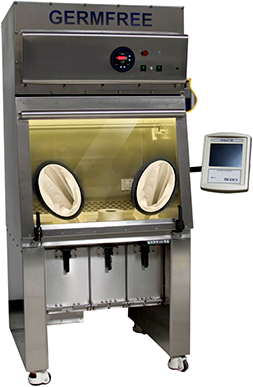13.9 Radioactive Pharmaceuticals
A specific kind of hazardous compounding occurs in a nuclear pharmacy, which prepares radioactive materials to diagnose and treat specific diseases. Nuclear medicine records radiation emitting from elements injected into the body, rather than from external elements like x-rays. Radiopharmaceuticals are irradiated HDs.

A compounding nuclear pharmacist or technician must be behind sealed lead protective casing with leaded glass shielding or have a computer screen for viewing the DCA.
Unlike a hazardous chemical CSP, these substances are not prepared in a hospital pharmacy. They are most commonly prepared off-site in a nuclear pharmacy by specially trained and certified nuclear pharmacists and pharmacy technicians. One nuclear pharmacy may serve nuclear medicine departments in several hospitals, with the radioactive drugs carefully transported to their sites. A nuclear pharmacy is similar to a compounding pharmacy in that it utilizes extensive, sophisticated equipment with no direct interaction with patients.
A nuclear pharmacy technician (NPT) prepares the radioactive pharmaceuticals. Working knowledge of these nuclear drugs and their risks and benefits is essential, as these technicians often advise medical providers regarding their toxic nature and their dangers. The NPT’s major tasks are to compound and dispense radiopharmaceuticals under direct supervision of the pharmacist; prepare and maintain compliance documentation of preparing and shipping products; and select, prepare, and stock medications and supplies.
The worker protection and medical surveillance programs for the nuclear pharmacy workers are even stricter than those for chemical hazardous drugs. Everyone working in a nuclear pharmacy, including the pharmacy technicians, must wear a radiation badge to detect exposure to radiation. Radiation exposure is kept to a minimum by the use of specifically designed equipment, syringes, gloves, and other devices. The radiopharmacy compounders must use leaded or tungsten glass syringe shields, transfer devices, and containers in the radiopharmacy isolator.
USP Chapter <821> Standards on Nuclear Medications
As with chemical HDs, the USP has articulated standards on radioactive medicine and pharmaceuticals in Chapter <821> Identification and Assay of Radionuclides. However, a need for change arose when the the positron emission tomography (PET) scan was developed. It is an imaging test that uses a radioactive drug as a tracer to help reveal the function of tissues and organs. Because of the short half-life of the radionuclide and the mode of production, PET drug products have unique storage, shipping, and handling concerns. USP Chapter <823> sets forth requirements for PET drug production, including control of components, materials, and supplies; verification of procedures; stability testing and expiration dating; quality control; and sterilization and sterility assurance. A full description of this chapter is beyond the scope of this text.
In 2018, the USP proposed a new General Chapter <825> tailored to the specific needs of sterile and nonsterile radiopharmaceutical preparations. USP Chapter <825> was written by an expert panel to provide clear standards that focus on the unique patient and provider needs of radiopharmaceuticals.
Training and Job Possibilities for Nuclear Pharmacy
To work in a nuclear pharmacy, a pharmacist must undergo 200 hours of classroom training and another 700 hours of experience under the observation of a qualified instructor. The nuclear pharmacy technician training program is intensive as well, though not quite as rigorous and time-consuming. These training programs are offered by the American Pharmacy Association (APhA).
There are fewer than 2,000 NPTs practicing in the United States. There is a shortage of certified technicians in this niche area of pharmacy, so it is a growing field, with salaries up to $55,000 per year with experience and credentials.